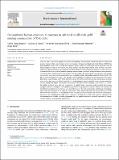Por favor, use este identificador para citar o enlazar a este item:
http://hdl.handle.net/10261/222752COMPARTIR / EXPORTAR:
 SHARE SHARE
 CORE
BASE CORE
BASE
|
|
| Visualizar otros formatos: MARC | Dublin Core | RDF | ORE | MODS | METS | DIDL | DATACITE | |

| Título: | Occupational human exposure to mercury in artisanal small-scale gold mining communities of Colombia |
Autor: | Calao-Ramos, Clelia; Bravo, Andrea G. CSIC ORCID ; Paternina-Uribe, Roberth; Marrugo-Negrete, José Luis; Díez, Sergi CSIC ORCID | Palabras clave: | Methylmercury Minamata Convention Urine Blood Hair Mining |
Fecha de publicación: | ene-2021 | Editor: | Elsevier | Citación: | Environment International 146:106216 (2021) | Resumen: | With the aim of protecting human life and the environment, the Minamata Convention seeks to reduce and monitor mercury (Hg) concentrations in the environment. Artisanal and Small-scale Gold Mining (ASGM) has been identified as the most important anthropogenic source of Hg at a global scale and an important route of human exposure to Hg. In this context, this study assessed total Hg (THg) in blood, urine and hair, and methylmercury (MeHg) in human hair samples from 238 participants with occupational exposure to Hg in the most relevant ASGM communities of Colombia. Mercury concentrations in different biological matrices were related to several variables of interest such as age, gender, body mass index, fish consumption, exposure time, and specific occupational activities, such as amalgamation and amalgam burning. The median values of THg in blood (3.70 µg/L), urine (4.00 µg/L) and hair (1.37 mg/kg), and hair MeHg (1.47 mg/kg) for all participants were below permissible concentrations set by WHO. However, about 40% of the miners showed Hg concentrations in blood, urine and/or hair above the WHO thresholds. In all the biological matrices studied, miners burning amalgams showed significantly higher concentrations than miners who did not burn amalgams, with values 7-, 7-, and 8-fold higher in blood, urine and hair, respectively. A multiple linear regression model revealed that burning amalgam and fish consumption were significant predictors of Hg exposure in miners. Miners from Guainía had the highest concentrations in urine and hair, most likely due to the high manipulation and burning of amalgam, and a high fish consumption. In contrast, miners from Caldas showed the lowest Hg concentrations in all the biomarkers because they do not manipulate or burn amalgam, as well as reporting the lowest fish consumption. Our study also highlighted that gold miners exposure to Hg depends on their work practices. Therefore, the implementation of a health education programme on gold mining strategies is required, especially in Guaina, Vaupés, Córdoba, and Antioquia departments. | Versión del editor: | https://doi.org/10.1016/j.envint.2020.106216 | URI: | http://hdl.handle.net/10261/222752 | DOI: | 10.1016/j.envint.2020.106216 |
| Aparece en las colecciones: | (IDAEA) Artículos |
Ficheros en este ítem:
| Fichero | Descripción | Tamaño | Formato | |
|---|---|---|---|---|
| Calao-Ramos et al EI 2021.pdf | Artículo principal | 2,5 MB | Adobe PDF |  Visualizar/Abrir |
| 1-s2.0-S0160412020321711-mmc1.docx | Material suplementario | 1,82 MB | Microsoft Word XML | Visualizar/Abrir |
CORE Recommender
SCOPUSTM
Citations
40
checked on 22-abr-2024
WEB OF SCIENCETM
Citations
30
checked on 21-feb-2024
Page view(s)
110
checked on 24-abr-2024
Download(s)
291
checked on 24-abr-2024
Google ScholarTM
Check
Altmetric
Altmetric
NOTA: Los ítems de Digital.CSIC están protegidos por copyright, con todos los derechos reservados, a menos que se indique lo contrario.
